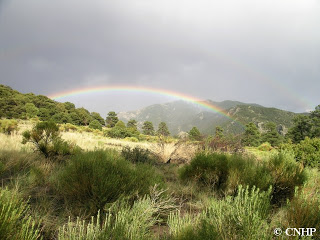 A view of the dunes from above
A view of the dunes from aboveField crews headed by CNHP Ecologist Joe Stevens have been working since 2005 at the Great Sand Dunes National Park and Preserve to classify and map the diverse vegetation of the Park as well as to collect and identify all known plant species within the Park.
The Great Sand Dunes National Park and Preserve showcases a wide range of ecosystems on a steep elevational gradient, going from dunes, shrublands, lakes and wetlands on the valley floor (7,550 feet elevation) through montane and subalpine forest, to alpine tundra at over 13,000 feet in the space of just three or four miles. The project area boundary encompasses 413,000 acres.
 There’s more to the Great Sand Dunes than just sand!
There’s more to the Great Sand Dunes than just sand!The vegetation mapping project is in collaboration with the National Park Service, U.S. Fish and Wildlife Service, U.S. Forest Service, U.S. Bureau of Reclamation, U.S. Geological Service, NatureServe, and The Nature Conservancy. The project is wrapping up this summer and will result in a detailed map of the area’s vegetation, descriptions of all the classified types, and a field key to the vegetation, representing approximately 200 different plant associations.
For the plant species collection project, CNHP assisted the Great Sand Dunes staff to identify vascular plant species within the Park, and to collect over 700 voucher specimens for the Park herbarium. A state-rare sedge, slender sedge (Carex lasiocarpa, G5S1) was documented, as well as western bitterweed (Rydbergia (Tetraneuris) brandegeei), a regional endemic found only in the Sangre DeCristo mountains in Colorado.
 The unusual Astragalus ceramicus (pottery milkvetch), found at the Great Sand Dunes
The unusual Astragalus ceramicus (pottery milkvetch), found at the Great Sand Dunes




